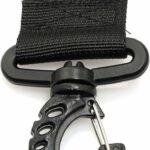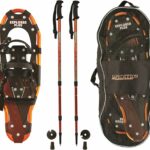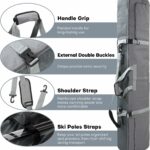Imagine having a day out on a snowmobile, the winter wind whipping past you as your machine carves paths in the untouched snow. The majesty of a snowy expanse stretches out before you, but how far can you actually go on your snowmobile before running out of power? Exploring the limits and what factors can influence the range of a snowmobile, “How Far Can A Snowmobile Go?” addresses this fun yet crucial question for all snowmobile enthusiasts. Strap on your helmet and make sure you’ve got a full tank as we embark on this information-packed expedition!
Understanding Snowmobile Basics
Definition of a Snowmobile
A snowmobile, also known as a motor sled or snow machine, is a land vehicle designed for winter travel and recreation. It’s specifically built for snowy terrains and doesn’t require a road or trail. Though they were once used mainly for work in snowy locales, their purpose has shifted considerably to adventure and fun.
How a Snowmobile Works
If you’ve ever wondered how these monstrous machines zip through the snow, here it is. Snowmobiles work based on the principles of internal combustion engines. Gasoline burns in the engine’s cylinders and produces hot gas, pushing the pistons down. This motion then turns the crankshaft, delivering power to the track system. The large, heavy tracks at the back give you that firm grip over the snow to propel you forward, while the skis at the front help with steering the machine.
Types of Snowmobiles
Snowmobiles come in various designs, each catered to different kinds of snow conditions and rider styles. You have trail models that are preferred for their comfort on groomed paths. Then there are high-performance models, built for speed and swift maneuverability. For deep snow conditions, mountain snowmobiles are the go-to choice with their long tracks and powerful engines. Lastly, you have utility snowmobiles, which are specially designed for heavy-duty work like towing and hauling loads.
Fuel Efficiency of Snowmobiles
How Much Fuel a Typical Snowmobile Uses
Fuel consumption varies with different snowmobile models. An average snowmobile could use somewhere between 10 to 20 gallons of fuel for a full day of hard riding. It’s advisable to always check your fuel gauge regularly, especially if you plan on covering long distances.
Factors Affecting Snowmobile Fuel Efficiency
Various factors can influence your snowmobile’s fuel efficiency. Some of the key ones include the machine’s size and weight, engine type (two-stroke or four-stroke), riding style, terrain, and weather conditions. For instance, aggressive riding or steep terrains can make your engine work harder, burning more fuel.
How to Improve Snowmobile Fuel Efficiency
There are a few ways to stretch your snowmobile’s mileage. Regular maintenance is a crucial one as an efficient engine burns less fuel. Also, riding at a constant speed rather than fluctuating speeds can also improve fuel consumption. Lastly, consider the terrain and weather – sticking to groomed trails and favorable weather conditions could help save on fuel.
Types of Snowmobile Engines and Distance Range
Two-Stroke Engines
Two-stroke engines, commonly found in older snowmobile models, do their job with only two movements of the piston. They’re quite efficient, providing a high power-to-weight ratio. However, they are not as eco-friendly or fuel-efficient as their four-stroke counterparts.
Four-Stroke Engines
Four-stroke engines are more sophisticated, offering better fuel efficiency and emission control. They perform their combustion cycle in four piston movements, causing them to run smoother and quieter than two-stroke engines. Over recent years, they’ve become the popular choice for most snowmobile manufacturers.
Comparison in Terms of Range
While two-stroke engines provide a quick burst of speed and are lightweight, four-stroke engines score when it comes to range and fuel efficiency. So, if you’re looking at covering long distances on your snowmobile, a four-stroke engine would be your best bet.
Impact of Terrain and Snow Condition on Distance
Effect of Terrain on Snowmobile Range
The type of terrain has a significant impact on how far your snowmobile can go. Flat, groomed trails are easy on your machine, allowing for better range compared with uneven, hilly terrains that can make your engine work harder, thus reducing the range.
How Snow Conditions Alter the Distance
Similarly, the snow’s condition can affect your snowmobile’s distance coverage. Hard packed or icy snow conditions are more suited for riding, offering better fuel efficiency. Deep, powdery snow, however, can prove challenging, bringing down the snowmobile’s range due to increased resistance.
Carrying Capacity and Their Effects on Distance
How Load Influences Snowmobile Distance
Just like gas-guzzling in your vehicle increases with weight, the same applies to your snowmobile. The heavier the load, the harder your engine has to work to propel, reducing your snowmobile’s distance.
Effect of Passenger Count on Distance
The number of passengers can significantly reduce your snowmobile’s range. Single-rider snowmobiles are designed to perform best with only the operator. Additional weight from passengers can strain the engine and consume more fuel.
Impact of Carrying Supplies on a Snowmobile’s Range
Carrying essential supplies is crucial for long rides, but remember it adds to your overall weight, decreasing your range slightly. It’s about balance – carry what you need for safety and sustenance, but try to keep it light.
Maintenance Influence on Snowmobile Capabilities
How Regular Maintenance Extends Your Range
Regular maintenance plays a vital role in extending your snowmobile’s range. When your engine is running efficiently, it burns less fuel, enabling you to cover more distance. Regular oil changes, making sure your spark plugs are clean, and keeping an eye on your air filters can make a world of difference.
Common Maintenance Procedures for Extending Distance
Common maintenance procedures include changing the oil, cleaning or replacing spark plugs, clearing clutches from any debris, and ensuring your tracks are in good condition. Notably, maintaining your carbides and sliders in good shape can significantly extend your snowmobile’s life and range.
Impact of Speed on Snowmobile Range
Relation between Speed and Fuel Consumption
Just like in a car, a snowmobile’s fuel consumption increases as the speed goes up. This happens because the engine has to work harder to maintain the high speed, thus burning more fuel.
Optimum Speed for Longest Range
The optimum speed for the longest range varies between snowmobiles, but generally, a moderate speed of around 30-40 mph is likely to offer the best fuel efficiency.
Snowmobile Accessories and Their Effects on Range
Role of Skis in Distance Coverage
The size and type of skis on your snowmobile can impact range. Wider skis provide better flotation in deep snow but can also add to the drag. On the other side, narrower skis are great for packed snow and help improve fuel efficiency.
Impact of Windshields
Having a decent windshield on your snowmobile can make your ride more comfortable. Moreover, it also helps improve aerodynamics, slightly reducing fuel consumption and extending your range.
Role of Track Length and Width
Longer and wider tracks are great for deep snow, providing better traction. However, they can also use more power, reducing range. Shorter, narrower tracks are preferable for better fuel efficiency when snow conditions allow.
Safety Precautions for Long Distance Travelling
Carrying Emergency Supplies
For long-distance travel, carrying emergency supplies like extra food, water, first-aid kit, flashlights, tools for snowmobile repair, and a communication device is paramount. Safety should always be your topmost priority.
Driving Safely Over Long Distances
Avoid high speeds and reckless maneuvering. Maintain a steady, moderate speed to conserve fuel. Also, don’t forget to take regular breaks to rest and avoid fatigue.
What to Do in Case of Break Down or Getting Lost
Having a pre-established emergency plan is crucial. If you break down or get lost, stay calm, stay put, shelter yourself, make your location visible, and signal for help.
Potential Limitations and Concerns when Covering Long Distances
Physical Limits of the Driver
Extended snowmobile rides can be physically demanding. Fatigue and cold can impact your responsiveness and decision-making abilities. It’s vital to recognize your physical limits and plan rest points along your journey.
Respecting Wildlife and Environmental Guidelines
Remember, nature is home to wildlife. Always respect the wildlife and adhere to the local laws and guidelines designed to protect the environment. Avoid riding in designated restricted or sensitive areas.
Potential Risks and Dangers
Long distance snowmobiling is not without its risks. Things like sudden weather changes, unforeseen obstacles in the terrain, mechanical issues, or an unexpected run-in with wildlife can pose potential dangers. Always be prepared for such scenarios and plan accordingly.
Overall, the distance a snowmobile can cover is influenced by various factors, including the type of engine, terrain and snow conditions, weight of the load, the speed at which you’re traveling, and more. By keeping these factors in mind and with proper planning and precautions, you can enjoy the thrill of a long-distance snowmobile journey safely and efficiently.
- What Snowboard Bindings Should I Get? - January 23, 2024
- What Size Screws For Snowboard Bindings? - January 23, 2024
- How To Snowmobile On Water? - January 23, 2024










